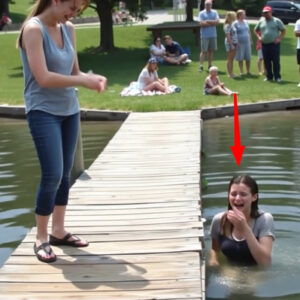Tourism often comes with breathtaking experiences, unforgettable memories, and occasionally, moments that take your breath away for reasons you never expected.
For a group of tourists enjoying a scenic bridge, one such moment turned into a scene of terror, testing their instincts, courage, and the rapid response of bystanders and emergency personnel.
This is the story of a bridge collapse that could have ended in tragedy, and the lessons it leaves behind about safety, preparedness, and the unpredictability of life.
A Day That Began Like Any Other
On what started as a beautiful day, a group of tourists was strolling across a popular pedestrian bridge in a bustling city known for its architectural marvels and picturesque views.
The bridge, a major attraction, spanned a river that cut through the city, offering panoramic views of both urban and natural landscapes.
Visitors often praised the bridge for its elegant design, wide walkways, and sturdy appearance, making it a favorite spot for photography and casual walks.
As the morning sun glinted off the water below, families, couples, and solo travelers meandered along the bridge, capturing selfies and marveling at the views.
The air was filled with laughter, the clicking of cameras, and the gentle murmur of conversations. No one anticipated the imminent danger that would turn this serene outing into a nightmare.
The First Signs of Trouble
According to eyewitness reports, the bridge began to exhibit subtle signs of stress before the catastrophic moment.
A few tourists noticed unusual vibrations underfoot, while others mentioned faint creaking noises that seemed louder than what one would expect from a standard pedestrian bridge.
These minor warning signs went largely unnoticed, as most people attributed them to the normal settling of the structure or the weight of the crowd.
Suddenly, a section of the bridge gave way. Tourists felt the floor shift beneath them, and panic erupted instantly. Screams filled the air as people struggled to regain balance.
Some clutched onto railings, while others instinctively tried to move toward the edges of the bridge that appeared to remain intact.
The chaos was amplified by the narrow pathways and the density of the crowd, creating a jumbled, disoriented scene where every second mattered.
Instant Reactions: Fear, Courage, and Chaos
In moments like these, human instincts are put to the ultimate test. Some tourists froze in shock, unable to comprehend the danger.
Others reacted quickly, helping friends, family members, and even strangers to avoid falling into the gap created by the collapsing section.
Several individuals pushed themselves into action, forming human chains to stabilize the more vulnerable and guide them to safer areas of the bridge.
Emergency personnel were called almost immediately, but in the first crucial seconds, bystanders became the first responders.
The ability of ordinary people to act decisively under stress likely prevented a far worse outcome.
Witnesses recounted gripping stories of tourists pulling children out of harm’s way and strangers holding onto each other to avoid being swept off the bridge entirely.
The Collapse: A Moment Frozen in Time
When the bridge fully began to collapse, it was a terrifying, slow-motion disaster that seemed almost unreal.
Chunks of concrete and metal shifted and fell, sending vibrations through the remaining structure. Dust and debris filled the air, creating a haze that added to the panic.
Some tourists managed to cling to railings, while others scrambled across the remaining sections to reach safety.
Eyewitness footage captured the moment in stark detail: the shock on people’s faces, the desperate attempts to hold on, and the chaos that unfolded in just a matter of seconds.
Fortunately, no fatalities were reported, though several individuals sustained minor injuries such as sprains, cuts, and bruises.
The quick reaction of both bystanders and emergency responders minimized the human toll, turning what could have been a catastrophic disaster into a near-miss that left a lasting impression on all involved.
Immediate Emergency Response
Within minutes, first responders arrived at the scene. Firefighters, paramedics, and police officers moved swiftly to assess the situation and tend to the injured. Tourists were evacuated to nearby safe zones, while emergency medical teams checked for more serious injuries. Ambulances transported those who required medical attention to local hospitals, and authorities cordoned off the affected section of the bridge to prevent further accidents.
Investigators quickly began analyzing the collapse to understand its cause. Engineers examined the structural integrity of the bridge, checking for weaknesses, metal fatigue, or signs of corrosion. Officials emphasized that while pedestrian bridges are designed to handle substantial loads, neglect, weathering, and lack of maintenance can combine to create unforeseen vulnerabilities.
The Human Side of the Incident
Beyond the physical damage, the emotional and psychological impact on the tourists cannot be understated. Many survivors described feeling an overwhelming sense of fear, disbelief, and helplessness.
Children were especially traumatized, and parents struggled to calm them while still navigating the dangerous situation.
Support teams were dispatched to provide counseling and guidance, ensuring that tourists received help in processing the incident.
Acts of heroism and compassion emerged as central themes in the aftermath. Strangers became instant allies, working together to ensure everyone’s safety. Social media buzzed with accounts of bravery, with many praising ordinary people who became extraordinary in moments of crisis.
Lessons Learned: Safety and Preparedness
The incident underscores the critical importance of infrastructure maintenance, emergency preparedness, and public awareness.
Authorities and city planners have begun discussions on reinforcing existing pedestrian bridges, implementing regular inspections, and ensuring that early warning systems are in place for signs of structural stress.
For tourists and pedestrians, the event serves as a reminder to remain vigilant in crowded or potentially hazardous areas. Awareness of your surroundings, understanding emergency exits, and following posted safety guidelines can make a significant difference in avoiding injury during unexpected incidents.
Broader Implications for Tourism
This near-tragic event has broader implications for the tourism industry. While cities and tourist attractions often emphasize beauty and accessibility, safety must remain a top priority.
Visitors expect experiences that are memorable in a positive sense, not frightening.
As a result, local governments, bridge authorities, and tourism boards are working together to ensure that infrastructure meets rigorous safety standards and that emergency response protocols are clear and effective.
Insurance and liability considerations also come into play. Attractions must ensure that they are prepared for unforeseen incidents to protect both visitors and their own operational integrity. Risk assessments, routine maintenance, and public education campaigns are crucial in maintaining confidence among tourists.
Psychological Effects and Community Response
Even after immediate physical danger has passed, incidents like a bridge collapse leave lasting psychological effects. Survivors often report anxiety when crossing bridges or traveling in crowded areas, and some experience post-traumatic stress symptoms. Counseling and community support are essential to help individuals recover fully.
In the community surrounding the bridge, the response has been one of solidarity. Residents and local organizations have come together to offer support, from providing temporary shelters for those affected to organizing awareness campaigns about infrastructure safety. Community resilience plays a key role in healing and ensuring that lessons are learned from such events.
Investigating the Cause
The collapse prompted a thorough investigation into the structural integrity of the bridge. Engineers and construction experts analyzed materials, design flaws, and maintenance records. Preliminary findings suggested that a combination of metal fatigue, inadequate inspections, and unexpected load stresses contributed to the partial collapse. Authorities are considering both immediate repairs and long-term redesigns to ensure the bridge meets modern safety standards.
This investigation also serves as a wake-up call for cities around the world. Aging infrastructure, especially in high-traffic tourist areas, requires constant monitoring. Preventive maintenance, timely upgrades, and public education campaigns can prevent similar incidents and save lives.
The Role of Technology
Technology played a crucial role in managing the aftermath of the collapse. Surveillance cameras captured the sequence of events, providing invaluable information for investigators. Social media allowed tourists to communicate with loved ones quickly, reducing panic and ensuring faster emergency responses. In addition, communication systems enabled rapid coordination between first responders, hospitals, and city officials.
Going forward, smart sensors embedded in bridges could provide real-time data on structural integrity, alerting authorities before minor issues escalate into dangerous situations. Investments in such technology are likely to become standard practice for high-traffic tourist areas and vital infrastructure worldwide.
Moving Forward
The bridge collapse, while terrifying, also highlights the resilience of the human spirit. Tourists, bystanders, and emergency responders demonstrated courage, quick thinking, and compassion under pressure. Lessons from the incident will guide improvements in safety, infrastructure maintenance, and community preparedness.
For tourists, the experience is a reminder that while travel offers beauty and adventure, it also requires awareness and caution. For authorities and city planners, the event reinforces the responsibility to ensure that public spaces are safe, reliable, and ready for unexpected challenges.
Conclusion: A Lesson in Awareness and Resilience
The collapse of a pedestrian bridge with tourists on it serves as a powerful reminder of life’s unpredictability. While the physical danger was contained, the emotional and societal impacts are long-lasting. Communities, authorities, and individuals must work together to ensure safety, preparedness, and resilience. The event underscores that disasters can happen anywhere, but human courage, solidarity, and technological support can mitigate their consequences.
Ultimately, this story is about more than a collapsing bridge—it’s about the strength of people in crisis, the importance of vigilance, and the ongoing responsibility of society to protect its members. Tourists walked onto a bridge expecting a scenic experience, but what they encountered was a moment of terror that transformed into a lesson in bravery, preparedness, and the value of human connection.





